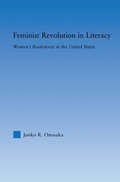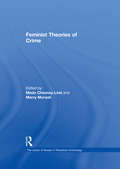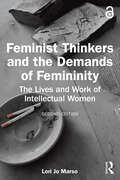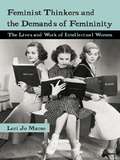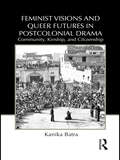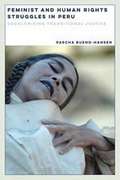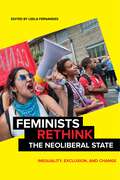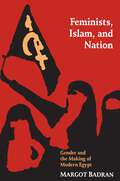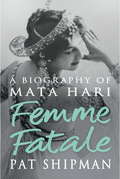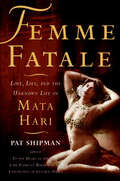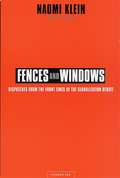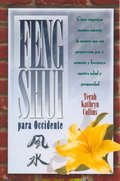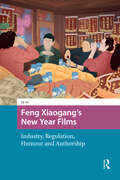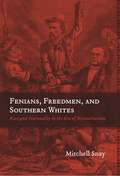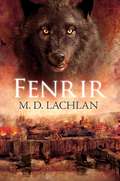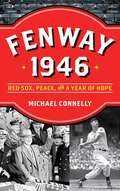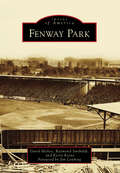- Table View
- List View
Feminist Revolution in Literacy: Women's Bookstores in the United States (Studies in American Popular History and Culture)
by Junko OnosakaThis book examines the history of women's bookstores in the US from the 1970s to the 1990s. It establishes that women's bookstores played an important role in feminism by enabling the dissemination of women's voices and thereby helping to sustain and enrich the women's movement. They improved women's literacy - their abilities to read, write, publish, and distribute women's voices and visions - and helped women to instigate a feminist revolution in literacy.
Feminist Subjectivities in Fiber Art and Craft: Shadows of Affect (Routledge Research in Gender and Art)
by John Corso-EsquivelThis book interprets the fiber art and craft-inspired sculpture by eight US and Latin American women artists whose works incite embodied affective experience. Grounded in the work of Gilles Deleuze and Félix Guattari, John Corso-Esquivel posits craft as a material act of intuition. The book provocatively asserts that fiber art—long disparaged in the wake of the high–low dichotomy of late Modernism—is, in fact, well-positioned to lead art at the vanguard of affect theory and twenty-first-century feminist subjectivities.
Feminist Theories of Crime (The\library Of Essays In Theoretical Criminology Ser.)
by Merry MorashThis collection re-imagines the field of criminology with insights gleaned from feminist theory. Works included here illustrate that gender is a key organizing principle of social life. This means that men and women have gender, that patriarchy as well as gender must be theorized, and that other systems of oppression such as race and class must also be studied to fully understand the crime problem and the criminal justice system. Finally, the articles collected here exemplify the feminist concern for thinking consciously about how and why we do our research with the crucial goal of producing knowledge that will promote social justice.
Feminist Thinkers and the Demands of Femininity: The Lives and Work of Intellectual Women
by Lori Jo MarsoExamining the lives and work of feminist thinkers throughout history, this book explores their struggles with politics, intellectual work, and material and existential conditions of femininity. A new introduction to this second edition resituates these themes in contemporary feminist literature and theory.Feminist autobiographical accounts exploring multiple lives and loves, encounters with political comrades and enemies, and frustrations with social expectations about feminine respectability, offer tastes of feminist lives across history and situation. But the stories are not always inspirational or exemplary. How do feminists survive and thrive in situations marked by intersecting harms of sexism, racism, and colonial and capitalist extraction? Thinking beyond representation and empathy as ways to connect, this book features disorienting and disruptive examples from feminist experiments in living and explores the uncomfortable feelings they invite in readers. Insisting that feminists should read the autobiographies and memoirs of feminist actors alongside their theoretical contributions, the volume features the work of Simone de Beauvoir, Emma Goldman, Ida B. Wells, Audre Lorde, Azar Nafisi, Ana Castillo, Carolyn Kay Steedman, Germaine de Staël, Mary Wollstonecraft, and more.Written for students and scholars of Women’s History, and everyone who “feels like a feminist,” this book embodies and electrifies the feminist insight that the personal is political.
Feminist Thinkers and the Demands of Femininity: The Lives and Work of Intellectual Women
by Lori MarsoExamining the lives and work of historical and contemporary feminist intellectuals, Feminist Thinkers and the Demands of Femininity explores the feminist struggle to "have it all." This fascinating interdisciplinary study focuses on how feminist thinkers throughout history have long striven to balance politics, intellectual work, and the material conditions of femininity. Taking a close look at this quest for an integrated life in the autobiographical and theoretical writings of well-known feminists such as Mary Wollstonecraft, Emma Goldman, and Simone de Beauvoir, alongside contemporary counterparts, like Azar Nafisi, Audre Lorde, and Ana Castillo, Marso moves beyond questions of who women are and what women want, adding an innovative personal dimension to feminist theory, showing how changing conceptions of femininity manifest themselves within all women’s lives.
Feminist Visions and Queer Futures in Postcolonial Drama: Community, Kinship, and Citizenship (Routledge Advances In Theatre And Performance Studies #17)
by Kanika BatraIn this timely study, Batra examines contemporary drama from India, Jamaica, and Nigeria in conjunction with feminist and incipient queer movements in these countries. Postcolonial drama, Batra contends, furthers the struggle for gender justice in both these movements by contesting the idea of the heterosexual, middle class, wage-earning male as the model citizen and by suggesting alternative conceptions of citizenship premised on working-class sexual identities. Further, Batra considers the possibility of Indian, Jamaican, and Nigerian drama generating a discourse on a rights-bearing conception of citizenship that derives from representations of non-biological, non-generational forms of kinship. Her study is one of the first to examine the ways in which postcolonial dramatists are creating the possibility of a dialogue between cultural activism, women’s movements, and an emerging discourse on queer sexualities.
Feminist Visual Activism and the Body (Routledge Research in Gender and Art)
by Basia SliwinskaThis book examines contemporary feminist visual activism(s) through the lens of embodiment(s). The contributors explore how the arts articulate and engage with the current sense of crisis and political concerns (e.g. equality, decolonisation, social justice, democracy, precarity, vulnerability), negotiated with and through the body. Drawing upon the legacy of feminist art historical critique, the book scrutinises activist strategies, practices and resilience techniques in intersectional and transnational frameworks. It interrogates how the arts enable the creation of civil and political resilience, become engaged with politics as a response to disaster capitalism and attempt to reform and improve society. The book will be of interest to scholars working in art history, visual culture, fine arts, women’s studies, gender studies, feminism and cultural studies.
Feminist and Human Rights Struggles in Peru: Decolonizing Transitional Justice
by Pascha Bueno-HansenIn 2001, following a generation of armed conflict and authoritarian rule, the Peruvian state created a Truth and Reconciliation Committee (TRC). Pascha Bueno-Hansen places the TRC, feminist and human rights movements, and related non-governmental organizations within an international and historical context to expose the difficulties in addressing gender-based violence. Her innovative theoretical and methodological framework based on decolonial feminism and a critical engagement with intersectionality facilitates an in-depth examination of the Peruvian transitional justice process based on field studies and archival research. Bueno-Hansen uncovers the colonial mappings and linear temporality underlying transitional justice efforts and illustrates why transitional justice mechanisms must reckon with the societal roots of atrocities, if they are to result in true and lasting social transformation. Original and bold, Feminist and Human Rights Struggles in Peru elucidates the tension between the promise of transitional justice and persistent inequality and impunity.
Feminists Rethink the Neoliberal State: Inequality, Exclusion, and Change
by Leela FernandesA rich set of feminist perspectives on the varied and often contradictory nature of state practices, structures, and ideologies Growing socio-economic inequality and exclusion are defining features of the twenty-first century. While debates on globalization, free trade, and economic development have been linked to the paradigm of “neo-liberalism,” it does not explain all the forms of social change that have been unfolding in comparative contexts. Feminists Rethink the Neoliberal State provides a timely intervention into discussions about the boundaries, practices, and nature of the post-liberalization state, suggesting that an understanding of economic policies, the corresponding rise of socio-economic inequality, and the possibilities for change requires an in-depth reconceptualization.Drawing on original field research both globally and within the United States, this volume brings together a rich set of perspectives on the varied and often contradictory nature of state practices, structures and ideologies in the post-liberalization era. The essays develop an interdisciplinary approach that treats an understanding of historically-specific forms of inequality—such as gender, race, caste, sexuality and class—as integral to, rather than as after-effects of, the policies and ideologies associated with the “neoliberal project.” The volume also tackles central questions on the restructuring of the state, the state’s power operations, the relationship between capital and the state, and its interactions with the institutions and organizational forms of civil society in the post-liberalization era. As such, Feminists Rethink the Neoliberal State examines both what is distinctive about this post-liberalization state and what must be contextualized as long-standing features of modern state power. A truly international and interdisciplinary volume, Feminists Rethink the Neoliberal State deepens our understanding of how policies of economic liberalization shape and produce various forms of inequality.
Feminists Who Changed America, 1963-1975
by Nancy F. Cott Barbara J. LoveDocumenting key feminists who ignited the second wave women's movement Barbara J. Love's Feminists Who Changed America, 1963-1975 will be the first comprehensive directory to document many of the founders and leaders (including both well-known and grassroots organizers) of the second wave women's movement. It tells the stories of more than two thousand individual women and a few notable men who together reignited the women's movement and made permanent changes to entrenched customs and laws. The biographical entries on these pioneering feminists represent their many factions, all parts of the country, all races and ethnic groups, and all political ideologies. Nancy Cott's foreword discusses the movement in relation to the earlier first wave and presents a brief overview of the second wave in the context of other contemporaneous social movements.
Feminists, Islam, and Nation: Gender and the Making of Modern Egypt
by Margot BadranThe emergence and evolution of Egyptian feminism is an integral, but previously untold, part of the history of modern Egypt. Drawing upon a wide range of women's sources--memoirs, letters, essays, journalistic articles, fiction, treatises, and extensive oral histories--Margot Badran shows how Egyptian women assumed agency and in so doing subverted and refigured the conventional patriarchal order. Unsettling a common claim that "feminism is Western" and dismantling the alleged opposition between feminism and Islam, the book demonstrates how the Egyptian feminist movement in the first half of this century both advanced the nationalist cause and worked within the parameters of Islam.
Femme Fatale: Love, Lies And The Unknown Life Of Mata Hari
by Pat ShipmanBiography of the most infamous woman of the early 20th century, the Dutch courtesan and alleged spy Margaretha Zelle (1876-1917), - Mata HariMata Hari was the prototype of the beautiful but unscrupulous female agent who used sexual allure to gain access to secrets, if she was indeed a spy. In 1917, the notorious dancer Mata Hari was arrested, tried, and executed for espionage. It was charged at her trial that the dark-eyed siren was responsible for the deaths of at least 50,000 gallant French soldiers. Irrefutably, she had been the mistress of many senior Allied officers and government officials, even the French Minister of War: a point viewed as highly suspicious. Worse yet, she spoke several European languages fluently and travelled widely in wartime Europe. But was she guilty of espionage?For all the publicity Mata Hari and her trial received, key questions remain unanswered. These questions concern not only her inadequate trial and her unproven guilt, but also the events in her personal life. What propelled Margaretha Zelle, destined to be a Dutch schoolteacher, to transform herself into Mata Hari, the most desirable woman in early 20th-century Paris? She danced before enthusiastic crowds in Paris, Berlin, Vienna, Madrid, Monte Carlo, Milan and Rome, inspiring admiration, jealousy, and bitter condemnation.Pat Shipman's brilliant biography pinpoints the powerful yet dangerous attributes that evoked such strong emotions in those who met Mata Hari, for hitherto the focus has been on espionage, not on exploring the events that shaped her life and caused her to transform herself from rural Dutch girl to international femme fatale.
Femme Fatale: Love, Lies, and the Unknown Life of Mata Hari
by Pat Shipman“An engrossing biography” of the Dutch exotic dancer accused of being a spy for the Germans during World War I.In 1917, the notorious Oriental dancer Mata Hari was arrested on the charge of espionage; less than one year later, she was tried and executed, charged with the deaths of at least 50,000 gallant French soldiers. The mistress of many senior Allied officers and government officials, even the French minister of war, she had a sharp intellect and a golden tongue fluent in several languages; she also traveled widely throughout war-torn Europe, with seeming disregard for the political and strategic alliances and borders. But was she actually a spy? In this persuasive new biography, Pat Shipman explores the life and times of the mythic and deeply misunderstood dark-eyed siren to find the truth.Praise for Femme Fatale“Her life’s story is a humdinger.” —Washington Post Book World“Pat Shipman reasons (and writes) like a born counterintelligence officer. Her gripping and well-developed account of the famed spy . . . will fascinate you right down to her grim imprisonment and hast execution in a desolate field outside Paris, her last performance faced, as were all of her life’s twists and turns, with bravery and grace.” —Peter Earnest, Executive Director, International Spy Museum, Washington, D.C., and former CIA Operations Officer
Femmes d’Écosse
by Helen Susan Swift Nicolas FrebillotFemmes d’Écosse est un voyage à travers le temps à la découverte de ces femmes qui ont fait l’histoire de leur pays. Des plus humbles aux plus grandes, les écossaises ont été sur le devant de la scène et en arrière-plan des principaux événements de leur pays. Voici les pêcheuses, les guerrières, les écrivains, les jacobites, les martyres et les ouvrières. Sans elles, l’Écosse ne serait pas l’Écosse. Rejoignez cette formidable épopée à travers les Âges Sombres et ce XXIème siècle et découvrez qui fut la force motrice de cette petite mais dynamique nation.
Fences and Windows: Dispatches from the Front Lines of the Globalization Debate
by Naomi KleinIn Fences and Windows, Naomi Klein offers a bird's-eye view of the life of an activist and the development of the anti-globalization movement from the Seattle World Trade Organization protests in 1999 through September 11, 2001. Bringing together columns, speeches, essays, and reportage, Klein once again provides provocative arguments on a broad range of issues. Whether she is discussing the privatization of water; genetically modified food; free trade; or the development of the movement itself and its future post 9/11, Naomi Klein is one of the most thoughtful and brilliant activists and thinkers for a new generation.
Fences, Gates and Garden Houses: A Book of Designs with Measured Drawings (Dover Architecture)
by Carl F. SchmidtA treasure trove of measured drawings and photographs, this volume depicts wood fences, gates, and small garden houses of New England. Several of these elegantly detailed constructions were built between the Revolutionary War and 1825, and many of them no longer exist. Restorationists and preservationists will find this collection a valuable resource.
Feng Shui para Occidente
by Terah Kathryn CollinsFeng Shui teacher Terah Kathryn explains why the arrangement of readers' homes and workplaces affects every aspect of their lives, including relationships, health, and finances. This informative text takes readers on a step-by-step journey through their home and office, opening their "Feng Shui eyes" to see the problems and the solutions in their environment.
Feng Shui: The Secrets of Harmony (Ancient Wisdom for the New Age)
by Sonya HwangGain prosperity, tranquility, and better health through the ancient practice of Feng Shui with this illustrated, introductory guide. Today, the notion that our well-being is influenced by the atmosphere of a place is widely accepted. The ancient Chinese developed this notion into a profoundly spiritual practice that decided everything from building design to furniture arrangement. This work explains how Feng Shui can help us improve our lives and fortunes by making changes to our living spaces. It discusses how feng shui can be used to promote self-awareness, positive health, and personal happiness, whether at work or in the home.
Feng Xiaogang’s New Year Films: Industry, Regulation, Humour and Authorship (Asian Visual Cultures)
by Qi AiThis book offers not only an in-depth study of Feng Xiaogang as a cinematic auteur but also a comprehensive and informative discussion of the industrial transformation of mainstream Chinese cinema under party-state regulation from the 1990s to the 2010s. It argues that Feng is not simply a commercially and artistically successful auteur but also a strategist who manages to achieve such success by his ability to negotiate governmental and market expectations. The negotiation facilitates his New Year filmmaking and dynamically affects the textual form of the resulting works. Feng engages in this textual construction, through which he delivers his own interpretations of the Chinese film industry’s state-led commercialisation, cultural policy, film regulation, and even political campaigns, establishes his authorship and restores his creative authority. Through this book, readers will comprehend the edges and limitations of auteur studies in order to understand the current cultural landscape of the film industry.
Fenians, Freedmen, and Southern Whites: Race and Nationality in the Era of Reconstruction (Conflicting Worlds: New Dimensions of the American Civil War)
by Mitchell SnayAfter the American Civil War, several movements for ethnic separatism and political self-determination significantly shaped the course of Reconstruction. The Union Leagues mobilized African Americans to fight for their political rights and economic security while the Ku Klux Klan used intimidation and violence to maintain the political and economic hegemony of southern whites. Founded in 1858 as the Irish Revolutionary Brotherhood, the Irish American Fenians sought to liberate Ireland from English rule. In Fenians, Freedmen, and Southern Whites, Mitchell Snay provides a compelling comparison of these seemingly disparate groups and illuminates the contours of nationalism during Reconstruction. By joining the Fenians with freedpeople and southern whites, Snay seeks to assert their central relevance to the dynamics of nationalism during Reconstruction and offers a highly original analysis of Reconstruction as an Age of Capital and an Age of Emancipation where categories of race, class, and gender -- as well as nationalism -- were fluid and contested.
Fenrir
by M.D. LachlanThe Vikings are laying siege to Paris. As the houses on the banks of the Seine burn a debate rages in the Cathedral on the walled island of the city proper. The situation is hopeless. The Vikings want the Count's sister, in return they will spare the rest of the city. Can the Count really have ambitions to be Emperor of the Franks if he doesn't do everything he can to save his people? Can he call himself a man if he doesn't do everything he can to save his sister?His conscience demands one thing, the demands of state another. The Count and the church are relying on the living saint, the blind and crippled Jehan of St Germain, to enlist the aid of God and resolve the situation for them.But the Vikings have their own gods. And outside their camp a terrifying brother and sister, priests of Odin, have their own agenda. An agenda of darkness and madness. And in the shadows a wolfman lurks.M.D. Lachlan's stunning epic of mad Gods, Vikings and the myth of Fenrir, the wolf destined to kill Odin at Ragnarok, powers forward into new territories of bloody horror, unlikely heroism, dangerous religion and breathtaking action.
Fenrir (The Wolfsangel Cycle)
by M.D. LachlanThe Vikings are laying siege to Paris. They want the Count&’s sister, in return they will spare the rest of the city. As houses on the banks of the Seine burn, a debate rages in the Cathedral on the walled island of the city proper. Can the Count really have ambitions to be Emperor of the Franks if he doesn&’t do everything he can to save his people? Can he call himself a man if he doesn&’t do everything he can to save his sister? His conscience demands one thing, the state demands another. The Count and the church are relying on the living saint, the blind and crippled Jehan of St. Germain, to enlist the aid of God and resolve the situation for them. But the Vikings have their own gods, and outside their camp, a terrifying brother and sister, priests of Odin, have their own agenda--an agenda of darkness and madness. And in the shadows a wolfman lurks. M. D. Lachlan&’s stunning epic of mad Gods, Vikings, and the myth of Fenrir, the wolf destined to kill Odin at Ragnarok, is a compelling mix of bloody horror, unlikely heroism, dangerous religion, and breathtaking action.
Fenway 1912: The Birth of a Ballpark, a Championship Season, and Fenway's Remarkable First Year
by Glenn Stout"After one hundred years, each time you walk up the ramp from beneath the stands and out toward that sea of sunlit grass, Fenway Park remains the most special kind of place there is, a place that can still change your life."In anticipation of the one hundredth anniversary of America's most beloved ballpark, the untold story of how Fenway Park came to be and its remarkable first season. 1912 was a leap year, the year the Titanic sank, and it was also the year baseball's original shrine, the one and only Fenway Park, was born. While the paint was still drying, the infield grass still coming in, the Red Sox embarked on an unlikely season that culminated in a World Series battle against the Giants that stands as one of the greatest ever played.Fenway 1912 tells the incredible story of Fenway, from the unorthodox blueprint that underlies the park's notorious quirks, to the long winter when locals poured concrete and erected history, to the notorious fixers who then ruled the game, to the ragtag team who delivered a world championship, Fenway's first.For all that has been written in tribute to the great Fenway Park, no one has ever really told the behind-the-scenes true story of its tumultuous yet glorious first year. Drawing on extensive new research, the esteemed baseball historian Glenn Stout delivers an extraordinary tale of innovation, desperation, and perspiration - capturing Fenway as never before.
Fenway 1946: Red Sox, Peace, and a Year of Hope
by Michael ConnellyBoston writer Michael Connelly captures the magic of America&’s return to normalcy after World War II in this intimate portrait of a city and the baseball team it loves. Fenway 1946 celebrates the city, the team, and the spirit of that wonderful 1946 season in Boston—a season, as usual, that broke fans&’ hearts—as America returned to return to peacetime pastimes. And none was more American than baseball.Along the way, Connelly brings out the stories and personalities that made that year so special in the Hub. For returning veterans like Ted Williams, young Congressman John F. Kennedy, and thousands of others and their families who worried while they were in Europe or the Pacific, the 1946 Red Sox season was a celebration. It was catharsis. It was what made America great.Husbands and sons were coming home to the open arms of a grateful nation. This included five hundred major leaguers who fought in World War II. The homecoming of America&’s best sparked a spirit of collective pride from coast to coast—and New England was not exempt. For the previous five years, America sat around its radio listening to war reports. Now they would gather in the parlors to enjoy baseball once again.Baseball had always been a thread that connected the country—a sport that linked generations. Opening Day 1946 was a tangible reminder that the country was at peace—back to the way things were. Nowhere was this more relevant than in Boston. From Scollay Square to South Boston to the North End, veterans in their uniforms, kids with bats over their shoulder, and housewives were talking about the return of Ted Williams and a roster that was considered the best in the league. Expectations were high—as always, at Fenway Park. Fans somehow knew this would be their year. The 1946 Boston Red Sox finished first in the American League with a record of 104 wins and 50 losses. And they wouldn&’t disappoint (until October).
Fenway Park (Images of America)
by David Hickey Kerry Keene Raymond Sinibaldi Jim LonborgFive days after the sinking of the Titanic, Boston's Fenway Park held its grand opening. Since that day, millions have witnessed the Red Sox play baseball. Their "Royal Rooters" evolved into the "Fenway Faithful" and are now commonly referred to as "Red Sox Nation." Nine World Series have been staged upon Fenway's turf, along with three Major League All-Star Games. Aside from baseball, Fenway has been host to professional and amateur football games, ice hockey, basketball, soccer, lacrosse, hurling, boxing and wrestling matches, and even a circus. Music from concerts has reverberated across its lawn, religious services have been held, and political rallies staged--all adding patches to the quilt of Fenway's rich, illustrious history. The structure that noted author John Updike referred to many decades ago as "a lyric little band box" has become one of New England's most beloved historical landmarks.
